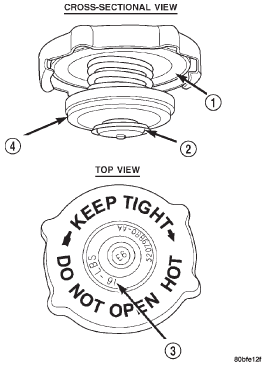 Jeep Cherokee Service ManualCooling system » Description and operation
Jeep Cherokee Service ManualCooling system » Description and operation
Radiator pressure cap
Radiator pressure cap
DESCRIPTION
All radiators are equipped with a pressure cap.
This cap releases pressure at some point within a range of 83-110 kPa (12-16 psi). The pressure relief point (in pounds) is engraved on top of the cap (Fig.
9).
The cooling system will operate at pressures slightly above atmospheric pressure. This results in a higher coolant boiling point allowing increased radiator cooling capacity. The cap contains a springloaded pressure relief valve that opens when system pressure reaches release range of 83-110 kPa (12-16 psi).
A rubber gasket seals radiator filler neck. This is done to maintain vacuum during coolant cool-down and to prevent leakage when system is under pressure

Fig. 9 Radiator Pressure Cap and Filler Neck-Typical
1 - FILLER NECK SEAL
2 - VACUUM VENT VALVE
3 - PRESSURE RATING
4 - PRESSURE VALVE
OPERATION
A vent valve in the center of cap allows a small coolant flow through cap when coolant is below boiling temperature. The valve is completely closed when boiling point is reached. As the coolant cools, it contracts and creates a vacuum in the cooling system.
This causes the vacuum valve to open and coolant in the reserve/overflow tank to be drawn through its connecting hose into radiator. If the vacuum valve is stuck shut, the radiator hoses will collapse on cooldown.
Cooling system
Automatic transmission oil cooler
Coolant reserve/overflow system
Cooling system fans
Block heater
Thermostat
Radiator
Radiator pressure cap
Water pump
Hose clamps
Viscous fan drive
Electric cooling fan
Jeep Cherokee Service Manual
- Lubrication and maintenance
- Suspension
- Differential and driveline
- Brakes
- Clutch
- Cooling system
- Battery
- Starting systems
- Charging system
- Ignition system
- Instrument panel systems
- Audio systems
- Horn systems
- Speed control system
- Turn signal and hazard warning systems
- Wiper and washer systems
- Lamps
- Passive restraint systems
- Electrically heated systems
- Power distribution systems
- Power lock systems
- Vehicle theft/security systems
- Power seat systems
- Power window systems
- Power mirror systems
- Chime/buzzer warning systems
- Overhead console systems
- Engine
- Exhaust system
- Frame and bumpers
- Frame
- Fuel system
- Steering
- Transmission and transfer case
- Tires and wheels
- Body
